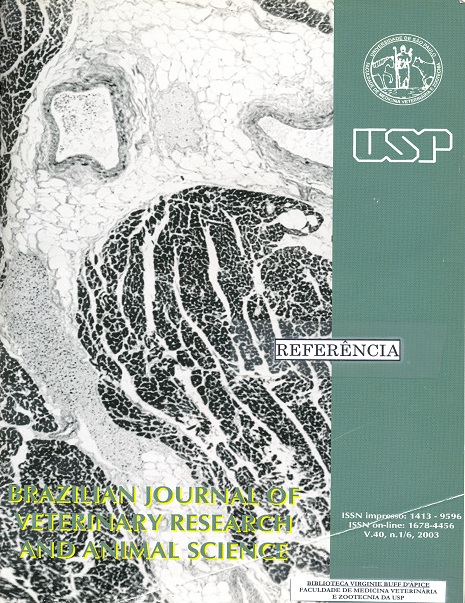Evaluation of experimental Toxoplasma gondii (Nicolle and Manceaux, 1909) infection in pigs by bioassay in mice and polymerase chain reaction
DOI:
https://doi.org/10.1590/S1413-95962003000300010Keywords:
Toxoplasma gondii, Pig, NestedPCR, Bioassay, DiagnosisAbstract
The aim of the present experiment was to standardize a nested polymerase chain reaction (nPCR) for the detection of Toxoplasma gondii in tissues of experimentally infected pigs and to compare the performance of nPCR with the standard isolation technique, the bioassay in mice. Comparison between the two methods was done testing eight 4 month-old pigs orally inoculated with 5 x 10(4) oocysts of Toxoplasma gondii (AS-28 strain) and three non-infected pigs at the same age, kept as control. All animals were euthanatized 47 days after infection and samples of brain, heart, tongue and retina were collected from each animal for analysis by nPCR and bioassay in mice. By using the bioassay, Toxoplasma gondii was detected in 4 infected pigs, being two in the retina, one in the heart and one in the tongue. Toxoplasma gondii DNA was detected in five of the inoculated pigs, being: three in the tongue, two in the brain and heart and one in retina. The detection threshold of the nPCR on mouse brain suspension artificially infected with the RH strain of Toxoplasma gondii was 10 tachyzoites/ml. Although both techniques were unable to detect the parasite in all infected pigs, nPCR showed better performance as it was accomplished in a shorter period of time. When used concurrently, both techniques detected the agent in seven infected animals. The only way to increase sensitivity of either method is to increase the amount of tissue to be examined.Downloads
Downloads
Published
2003-01-01
Issue
Section
UNDEFINIED
License
The journal content is authorized under the Creative Commons BY-NC-SA license (summary of the license: https://
How to Cite
1.
Yai LEO, Vianna MCB, Soares RM, Cortez A, Freire RL, Richtznhain LJ, et al. Evaluation of experimental Toxoplasma gondii (Nicolle and Manceaux, 1909) infection in pigs by bioassay in mice and polymerase chain reaction. Braz. J. Vet. Res. Anim. Sci. [Internet]. 2003 Jan. 1 [cited 2025 Apr. 5];40(3):227-34. Available from: https://revistas.usp.br/bjvras/article/view/11361





